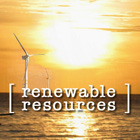
|
OIL-RICH STATE USES FORWARD-THINKING INITIATIVE TO POSITION ITSELF AS WIND-ENERGY HEAVYWEIGHT 7 August 2007 :: Lainey Johr "A typical coal-fired power-plant is 300 megawatts", reminds the ecological researcher and author, Lester Brown. In Texas, in a demonstration of what he calls "quantum-jump thinking of what the future might look like", thy're building a wind-harvesting industry that will produce 7,000 megawatts of electricity. This is a huge advance for the economical commitment to renewable resources. The "wind farm" per se is likely to be spread out over several projects, in various parts of the state, and may be built by a number of different companies. The figure of 7,000 megawatts is specifically derived from a plan by Gov. Perry, a Republican, to revitalize Texas' electricity sector and to create jobs by building his state into a major player in the market for harvesting wind energy. The state's potential for wind power generation could reach 10,000 megawatts by 2012, given the installation of additional power transmission lines adequate for increased power generation in particularly wind-rich areas. Newly identified Competitive Renewable Energy Zones (CREZ's) are being sought for new power lines and future wind farms, ensuring that the lines are safe, cost-effective and reliable when the farms are ready to produce energy. The governor hopes that the new plan outlined in Senate Bill 20 will bring renewable, clean energy from otherwise remote areas of the state to its urban centers. This will likely cost hundreds of millions of dollars and take anywhere from five to seven years to complete. A new February ruling by the Federal Energy Regulatory Commission gives greater flexibility to wind power generators by exempting intermittant power generators, such as with wind power, from excessive 'imbalance' charges incurred when the plant produces less energy than it forecasts. This move is designed to encourage development of the renewable energy sector in part by removing some of the overwhelming discretion over the unused capacity of power lines away from transmission providers and giving more control to the energy suppliers. Under the new ruling, transmission line providers must work with the North American Reliability Corporation, whose job it is to oversee efficient means of calculating power transmission capability and to increase transparency by making the calculations public, thus disabling total control and possible manipulation of power sources through the transmission lines. Texas has the most wind generating-capacity, surpassing California just last year. The state's unusual position of having most of its power grid within the state border necessitates its own regulatory commission to monitor power operations, without federal oversight. This level of control over its power grid is partly touted as the reason for the state's unique and forward-thinking solution to its energy demands. [s]
PINK SOLAR CELLS CAN PRODUCE POWER AT 25% OF CURRENT COST As environmental groups, lobbyists and the general public push for more environmentally friendly industrial practices, scientists are finding innovative ways to bring down costs and increase the efficiency of renewable resources. The dye-sensitive solar cells (DSSC), with a pinkish sheen, now being developed at Ohio State University, are an example of the type of engineering innovation that could bring about a genuine green-power revolution. [Full Story] GEOTHERMAL: WEST DIGS DEEP FOR THE NEXT BIG THING IN POWER Geothermal energy is increasingly being touted by scientists and researchers as one of the most efficient and environmentally friendly sources of power available. Currently, geothermal sources supply enough energy, 2,800 megawatts, to run 2.8 million American homes. The potential of geothermal energy in the US is even greater than once believed, at an estimated 13,000 megawatts over the next 10 years; but only the western states of Utah, Nevada and California have active geothermal power stations. [Full Story]
|
||||||||||||||||||||||||||||||
|
|||||||||||||||||||||||||||||||








